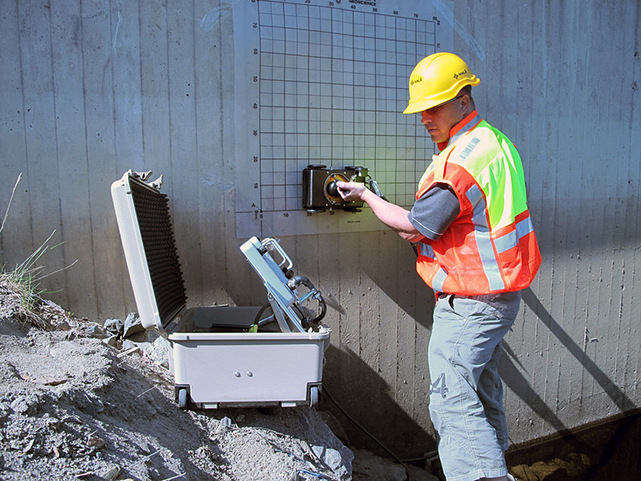Discovering the Depths: A Comprehensive Guide to Concrete Scanning and Its Diverse Applications
In the realm of building and infrastructure growth, the thorough procedure of concrete scanning holds an essential function in ensuring the structural stability and security of projects. As modern technology continues to advance, the applications of concrete scanning have broadened much beyond plain surface-level analyses.
Value of Concrete Scanning
Recognizing the relevance of concrete scanning is vital in ensuring the safety and honesty of frameworks throughout building and construction and improvement tasks. Concrete scanning makes use of innovative modern technologies such as ground-penetrating radar (GPR) and electro-magnetic induction to find ingrained items, voids, or various other abnormalities within concrete frameworks.
Furthermore, concrete scanning plays a critical role in making certain compliance with building regulations and guidelines that mandate the security of existing architectural components throughout construction activities. By precisely mapping out the interior composition of concrete, scanning modern technologies make it possible for building specialists to make enlightened choices that support the structural security and durability of structures and framework projects. In essence, the relevance of concrete scanning depends on its capacity to secure both the architectural honesty and the personnel associated with building ventures.
Technologies Made Use Of in Concrete Scanning
Concrete scanning counts on innovative modern technologies such as ground-penetrating radar (GPR) and electro-magnetic induction to accurately find embedded objects and anomalies within concrete structures. Ground-penetrating radar runs by emitting high-frequency electromagnetic waves into the concrete.
Electromagnetic induction, on the various other hand, works by creating electromagnetic areas around a concrete framework with a transmitter coil. When steel things exist within the concrete, they disrupt these magnetic fields, causing eddy currents to move through the metal. By measuring the changes in the electro-magnetic fields with a receiver coil, the system can determine the area of metallic objects in the concrete.
These advanced innovations play a critical duty in non-destructive screening, ensuring the security and stability of concrete frameworks in various markets.
Applications in Building Industry
Within the building industry, concrete scanning innovation finds diverse applications that improve job effectiveness and safety and security. Additionally, concrete scanning is used for locating gaps, such as air pockets or areas of degeneration within concrete, which can endanger the overall stamina of a framework. Concrete scanning plays an essential function in quality control by validating the density of concrete covers over support, guaranteeing compliance with layout specs and standards.

Security Benefits of Concrete Scanning
In the realm of building security, the implementation of concrete scanning innovation presents a paramount benefit in preemptively recognizing potential risks and fortifying structural stability. By utilizing advanced scanning methods such as ground-penetrating radar (GPR) and electro-magnetic induction, building and construction teams can accurately locate rebar, post-tension cords, conduits, and other surprise items within concrete frameworks. This positive method significantly lowers the danger of unintentional strikes during drilling, cutting, or coring activities, consequently preventing costly damages, injuries, and job delays.
Additionally, concrete scanning enhances employee safety by giving real-time details regarding the architectural condition of concrete elements. This information enables building specialists to evaluate the integrity of existing structures, identify deterioration or problems, and make educated choices relating to fixing and upkeep procedures. By resolving possible safety concerns quickly, concrete scanning adds to developing a safe and secure working atmosphere and minimizing the probability of structural failures or mishaps on construction websites. Ultimately, the security benefits of concrete scanning not just secure lives and properties but likewise support sector standards for top quality and dependability.
Future Trends in Concrete Scanning
Emerging advancements in scanning innovation are positioned to change the area of concrete examination and analysis. By using the power of AI, these systems can analyze huge quantities of information accumulated throughout scanning procedures to offer even more exact and detailed understandings right into the condition of concrete structures.
One more significant fad is the growth of even more portable and user-friendly scanning devices. Miniaturization of scanning tools permits less complicated accessibility to confined spaces and remote areas, making assessments website link extra comprehensive and effective. In addition, developments in cordless interaction modern technologies enable real-time data transfer and evaluation, helping with quicker decision-making procedures.
Additionally, there is a growing concentrate on sustainability in concrete scanning modern technologies - RainierGPR Concrete Scanning. Suppliers are progressively including environmentally friendly products and energy-efficient attributes into their tools to lower ecological effect. These future patterns are established to boost the performance, precision, and sustainability of concrete scanning techniques, forming the market's future landscape
Conclusion
To conclude, concrete scanning plays a crucial duty in the construction industry by ensuring the safety and security and effectiveness of various jobs. By utilizing innovative modern technologies, such as GPR and radar imaging, specialists have the ability to precisely detect prospective risks within concrete try these out structures. The applications of concrete scanning are substantial and continue to develop, making it a vital device for preserving the stability of structures and infrastructure. As modern technology breakthroughs, the future of concrete scanning holds appealing developments for enhancing building processes.
